While local bridge traffic is back to around 90 percent of its pre-Covid volume, BART ridership is still down by nearly 80 percent and weekly office attendance within the San Francisco Metropolitan area – which includes Alameda, Contra Costa, Marin, San Francisco and San Mateo counties – is still under 30 percent, according to the latest re-opening report from San Francisco’s Office of the Controller and Economic Analysis.
That being said, there are 31,500 more employed residents in San Francisco than there were at the same time last year and the unemployment rate in the city has dropped to 3.9 percent, as we outlined last week.
But there are still 30,600 fewer employed people in San Francisco than there were prior to the pandemic and 21,800 fewer people in the labor force, which has stalled the recovery in rents. And while the lifting of international travel restrictions two weeks ago should give the local hospitality sector and employment a boost, the average hotel occupancy rate in the city has yet to climb back over 50 percent and the average daily rate, which was averaging over $300 prior to the pandemic, has been hovering around $180 per night.
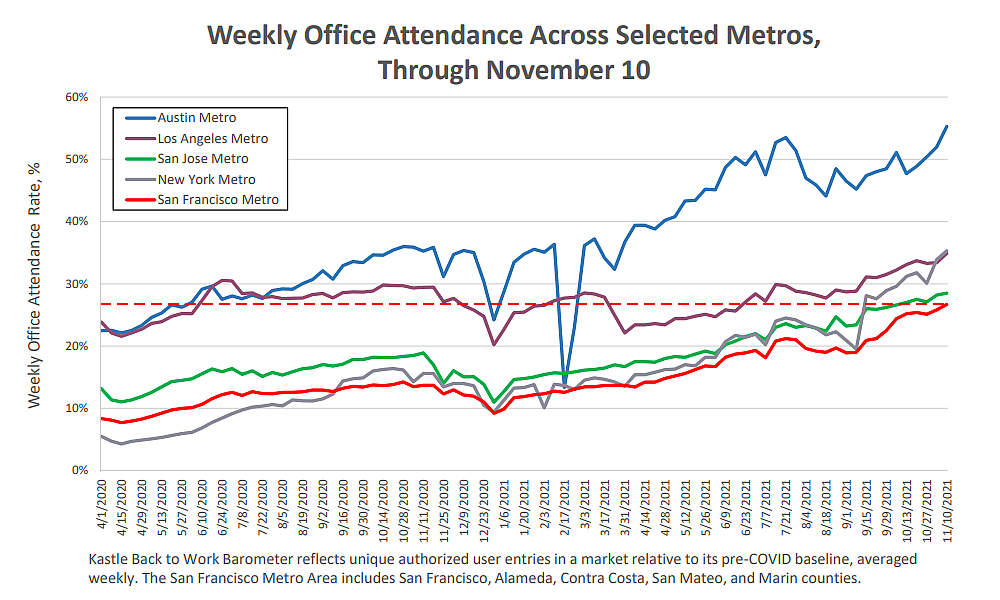
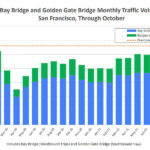
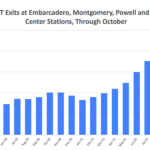
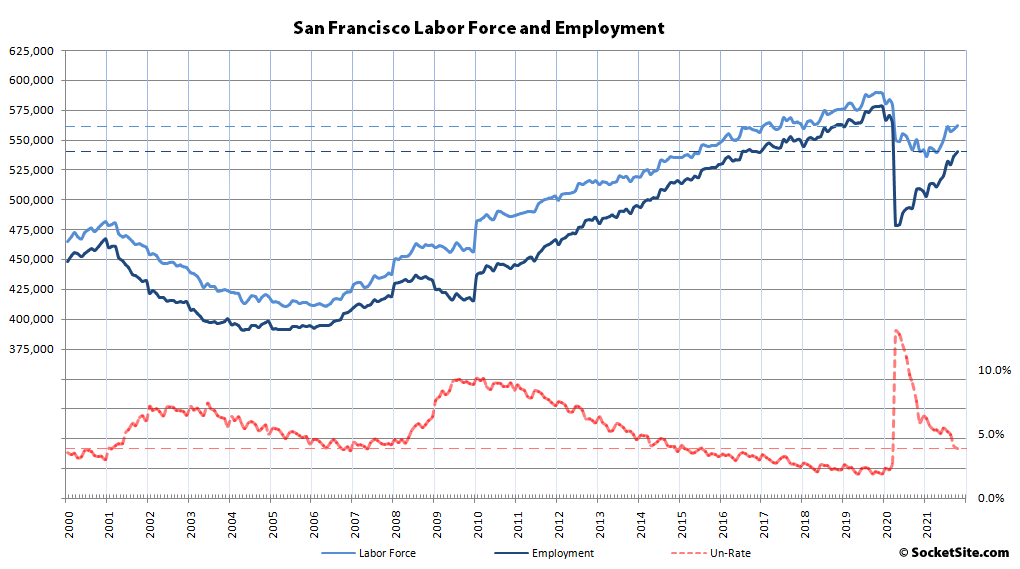
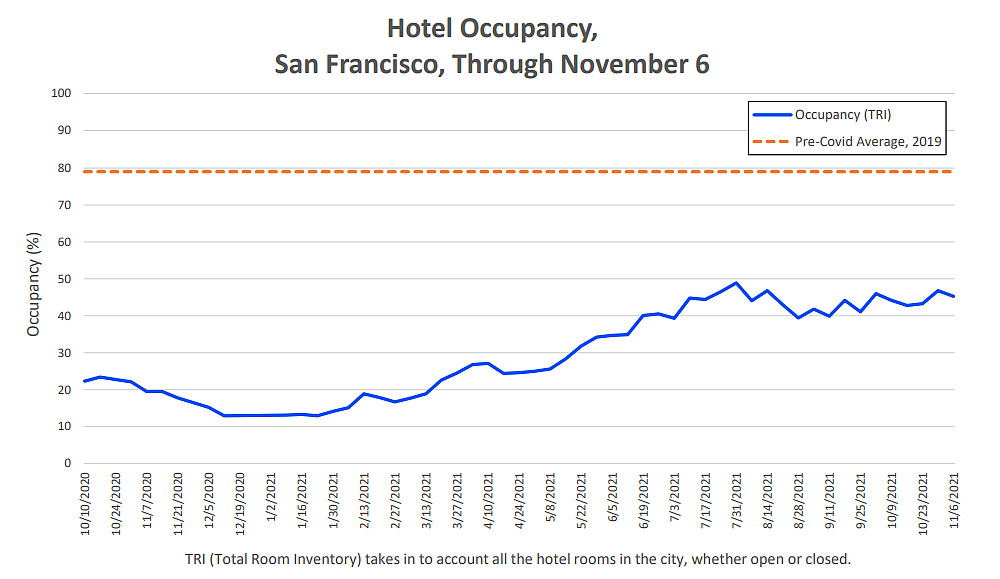
A couple of observations:
– There’s been a mode shift from BART to driving over the bridge. Office attendance is a third of normal, BART ridership is barely 20%, but Bay Bridge traffic is almost back to normal.
– Austsinites are romantic, taking the week of Valentine’s day off from work 🙂
positive spin: Office occupancy in SF has gone up 300% since April 2020, whereas Austin’s has only doubled, and Los Angeles’ has only gone up about 30%.
Weekly office attendance is key and, at present, not good for downtown stores and restaurants. Given the new work model it is not a sure bet it will ever return to pre-pandemic levels. The trend continues as Citicorp put up for sublease half its SF office footprint last week (due to new work model and shifting jobs out of SF) and Scribd did the same last week with all of its SF footprint as it leaves. One week and another 130K or so feet of space added to sublease market.
I have a neighbor and know 2 others who work in the administrative department of UCSF. They are now permanent teleworkers. Don’t be surprised if UCSF gives up some of its administrative office space as it too shifts its work model. BTW, my acquaintances count as living in SF with jobs but they no longer frequent the restaurant and shops they once did when they worked in SOMA – a permanent loss of business.
San Francisco is ranked as the worst or second worse metro in terms of the hospitality industry recovery. SF is lagging other metros which are expected to recover in 2022 while SF is projected to recover in 2024 or 2025. The ongoing negative national news about SF is making matters worse. This weekend’s smash and grab events in Union Square is even getting international coverage. Retailers can’t endure the “street” situation downtown. Gump’s, whose lease is up in a few years, is threatening to leave SF at that time if things don’t turn around.
There a perfect storm brewing.
One thing that is good – the recovery in the rental market has stalled. Let’s hope there is a permanent reset to more affordable rents in SF.
So basically these 5 metros rank in order of Covid prevention/regulation compliance. I wonder if per capita infection rates follow similar lines? (I’m not begging the question, I do wonder that.)
@Seattle Dude – Gumps went out of business a few years ago. Some company bought it and tried bringing it back a year or two later but if you’re telling me it’s still open on Post st I’m very surprised!
FWIW, Texas’ covid death rates were 5x that of CA per capita during Delta, and it’s still notably higher. Not exactly the same as urban/city comparison, but it certainly is telling.
Yes. It reopened in 2019 after bankruptcy with new ownership. At the time it took a two year lease on Post – not committing to stay in SF after that. Gump’s CEO John Chachas said he’s considering moving the company out of San Francisco, “unless this nonsense ends”.
If Union Square continues its decline as a destination shopping area there is no reason for Gumps to stay. Palo Alto, Walnut Creek or an upscale part of Oakland would be viable options for a relocation.
This isn’t a San Francisco thing. It’s happening in Walnut Creek, San Jose (Santana Row), Hayward (Southland Mall) and Concord (Sun Valley Mall), too.
And Chicago, among many others. This is all over the country.
And NYC – both midtown Walgreens and Duane Reade have been hit repeatedly.
Watch your apologism. Smash and grab and high value shop lifting has been more brazen, more wide spread and gone on for much longer in SF than in any of those other locations. Southland in Hayward was only hit twice this entire year, going back 3 years Walnut Creek has only seen ~6 high value incidents and only 2 when stores were busy with customers. Some stores in SF have been hit so many times that they’ve gone out of business. So let’s not get all “look over there” about this. The problem is very real and needs addressing. SF needs retail and tourism to pay for city services… it’s not a joke.
I was in the office today, and I went to grab a sandwich at my favorite soma deli. This being the Tuesday before TGiving compounded with the new norm and I expected to breeze in and out. I actually had to wait in line for at least 20 minutes to order, just like the pre-covid days. Interesting.
I think it’s a combo of returning workers and many other shops having closed (so those who are downtown have fewer options). Also less in-office catering, at least from my perspective.
This number is going to rise rapidly, though. Our firm recently announced (as a “perk”) a new policy that starting in January, we “get to” work up to 2 days a week at home. Translation (and *not* explicitly stated, which was interesting) – as of January, we’ll be obligated to spend at least 3 days a week in the office…
I think the glitch was his willingness to actually pay for something: I saw “grab a sandwich” and thought….
Anyway, if your situation is typical, it would imply “occupancy” flattening out around 60% – much like the hotels seem to be doing 🙁 If so, while it won’t matter much to lessors, I suppose – since the space would still need to be leased – but would be quite traumatic to the businesses that depend on people actually being around 5 days/week.
No way in H, E, “Double Hockey-sticks” I am commuting the 101 back to the old office (mid peninsula) after nearly 2 years of WFH given gas prices are going to hit $6/gallon soon with no other reasonable options.
I predict spiking gas prices to be the next mitigator of all these firms thinking people want to pay that and waste over 2 hours of their day in cases where it is entirely unavoidable, mainly tech/office roles.
The new post pandemic bay area world won’t tolerate $6/gallon gas and housing 20%+ more expensive on top of wasting your life on the 101.
I think it’s a combination of SFers are WAY more able to telecommute as a new default and this homeless and invasion theft thing.
It sounds very un-SFer, but I’m a native and remember when the aggressive panhandling got to a point that people started smashing on the homeless. Now it’s gotten to the point that they’re outnumbering citizens.
The other issue is who buys at a physical store anymore? I do all my shopping online. I’m warm, comfy, no traffic, lines, etc. I just get it all delivered. Maybe modern society is changing and these dope-fiends and hood-rats are just grabbing at the low-hanging luxury fruit of society’s old business model.
They need to make a new law that makes group invasion robberies a 5 year minimum (8 years with priors) and it would end overnight. The risk-reward for kids still favors it continuing.
The pandemic accelerated the move to online shopping. But how we shop was inevitably going to change. That means requiring retail space at the street level of new developments should not be a hard and fast rule. Many of those retail spaces will not find tenants. Restaurants are a different thing. Eating out will continue and restaurant space will have greater demand going forward. That said, for any retail area to thrive in the new norm two things are needed first – safety of shoppers and cleanliness of the streets. SF has to radically step up on that or indeed Gumps and others will leave. IKEA has already delayed it’s Market St. debut in light of the current situation. It’s not a given IKEA will open at that location.
Whether its 3/2 or a full 5 day telework schedule, offices won’t be as occupied as they once were. The new mode for work is transformational. Akin to going from the horse and buggy to autos. Many still refuse to see that and its implications. One of those implications will be the emergence of hub offices in metros throughout the country as the workforce gets more dispersed. Hub offices will be placed generally in a location central to the metros population and easy to get to. That means SF will not fare well. Oakland and the East Bay are set to see major jobs and population growth as the new work dynamic emerges. While the new 5M tower sits empty and 88 Bluxome’s developers have given up on office space (they are trying to make it lab space while eliminating the tennis courts which is not going to fly with the Supes) a new large spec office tower was just announced for Oakland by the Ellis Group and Boston Properties. No way developers would do a spec building in SF today.
So, in addition to the streets and crime, SF needs to go after biotech jobs. That may be the only game in town now as the office and tech workforce declines. One good feature – lab workers generally can’t telework which will provide a boost for local shops and restaurants close to biotech offices.
No way developers would do a spec building in SF today.
As much as I always want to join in for Oakland boosting, the evidence on these pages refutes your claim, as there are still 4-5 such announcements for the west Bay for each in the East. Not that any of them will necessarily be built. And Oakland’s safety is still much worse than SF’s…even for those who measure incidents/sq cubit.
But yes, the gap seems to be closing: The Town’s seeming wish to be more like The City may come true yet…to everyone’s displeasure.
The most recent iteration of Gumps, although in its original brownstone building, holds a small fraction of the floor space of the former location and is only a faint image of itself. A better bellwether might be Williams & Sonoma or Saks, or maybe the Gensler remodel (or “transformative repositioning”) of the once travertine-clad Macy’s men store now broken up into smaller units. What type of new tenants go in might give a good indication of the future of Union Square.
And despite the popularity of the internet for shopping, people still do need to feel, smell, and look closely at certain types of products, especially luxury goods.
Brownstone…are you sure? I thought it was cast iron.
No matter…and I agree w/ your second point: ”feel” is very important for some (as a side note: the arresteees in WC were described as from Oakland and SF. I guess the derisive comments we saw (even on these pages) about the bridge and tunnel crowd knew what they were talking about….even if they had the wrong tunnel.)
You’re right about Gump’s cast iron – I remembered it from childhood when it seemed to be painted a dull brown. Is the Pacific-Union club the only brownstone in SF? It looks as if the Gensler building was clad in a kind of white terra cotta, of which the Historical Preservation Commission wanted even more (I was at the hearing) and asked for the structure to be crowned with some “contextual” cornice work. It could be an attractive location for a group of related businesses wanting to move into a crisp new building with smallish bright spaces – a design center north?
Ikea is currently having enough trouble stocking its shelves, so that could be a reason for not opening a San Francisco store right now. When the building was approved at the Planning Department, it was done so by giving impression that Target was anxious to move in (which it was in fact not), so it does have lots of parking for customers who might want to slip in and out unnoticed.
I looked it up (in Splendid Survivors ) and the description was that it was “Colusa Sandstone”…a commonplace material in California which IIRC is naturally a grey color….so whatever the material is it’s been painted. The Gensler (macy*s/I Magnin) building is definitely marble faced, it was thoroughly described in the links in the original story.
Oops!! Sorry: got the macy*s conversions confused; the original was travertine clad, tho I guess you’re referring to the rebuilt structure.
Union Square’s merchants could have a underwhelming Christmas season now that cars will be restricted in the area between 7PM and early morning. That’s not the kind of signal one wants to send but it’s so bad downtown that city officials had no choice. BTW, if anyone thinks IKEA is going to open on Market Street next year think again.
What’s the future for Union Square? TBD, and it may be years before there is an answer. The Gensler remodel looks great but I suspect the retail spaces will sit mostly empty for a long while and that, especially so, if the idea was to have them be upscale retailers. The hotel/convention industry is vital for Union Square and SF is at the bottom of any metro in terms of a recovery from the pandemic lows.
Crime/safety issues and the filthy streets with aggressive panhandling are keeping folks away from SF. I know a number of families who traditionally made a Christmas shopping trip to Union Square prior to the pandemic. They are no longer going to do that.
Then there is J. P. Morgan telling business leaders involved with organizing its prominent San Francisco biotech event that the company is considering moving to a virtual format over safety concerns. J.P. Morgan employees are concerned over the mass retail thefts in Union Square and don’t have confidence that the city can keep people safe. As it is convention bookings are running at just 50% of pre-pandemic levels. Losing a live biotech event set for January would further dampen hopes for a recovery in the convention industry.
It’s up to the City PTB. They are starting to panic at the loss of business (tax revenue) but will they take aggressive action? Some have their doubts. Oakland apparently does as they’ve announced a major expansion of their convention center with a vibrant outdoor esplanade. They apparently expect SF to continue to lose convention business and are going to try to capture some of the exodus.
Will Nero continue to fiddle?
Nero can play his harmonica without worry: even expanded – it opened c 1980 and was small even by the standards of the day – Oakland’s CC could fit in the lobby of Moscone.